Why didn't we involve the 4 Ohm resistor while doing the mesh i2 ?
Asked
Active
Viewed 80 times
0
Voltage Spike
- 75,799
- 36
- 80
- 208
JuanDoe
- 1
- 2
-
A mistake? Slip of the pen? – G36 Dec 17 '20 at 20:52
-
I have no idea, I thought maybe it's because that part is an open circuit, so – JuanDoe Dec 17 '20 at 20:56
-
No, what is the answer for the Thevenin voltage? And \$V_\phi\$ is? – G36 Dec 17 '20 at 20:58
-
Vϕ is 20V, Voc is 120V ,i source(when you make it a short circuit)=40 ohm, Rth is 3 ohm, Vth is 60 Volt – JuanDoe Dec 17 '20 at 21:05
-
I meant, what is the "parameter" for \$V_\phi = 4\Omega \times I_1 \times What\$ – G36 Dec 17 '20 at 21:07
-
Im sorry I still don't understand but Vϕ =4(i1-i2) , but i assume you already know this, I didn't get the parameter part though – JuanDoe Dec 17 '20 at 21:11
-
But \$V_\phi\$ is a Voltage controlled Voltage source, so you need to know the "control parameter" value (VCVS gain). – G36 Dec 17 '20 at 21:15
-
And the second mesh equation should look like this: \$-V_\phi + 8\Omega I_2+4\Omega(I_2 - I_1)=0\$ – G36 Dec 17 '20 at 21:19
-
Yes, I think so, too. However the solution was different but as you said it might be a mistake, so thank you – JuanDoe Dec 17 '20 at 21:22
-
Also noticed that the control voltage (in blue) for your VCVS is equal to \$V_\phi = 4\Omega I_1\$ – G36 Dec 17 '20 at 21:26
1 Answers
0
Your first loop equation is correct. For the dependent source, only the i1 current needs to be taken into consideration. We can use the outer loop for finding Vth.
Kaswechiha
- 474
- 4
- 11

